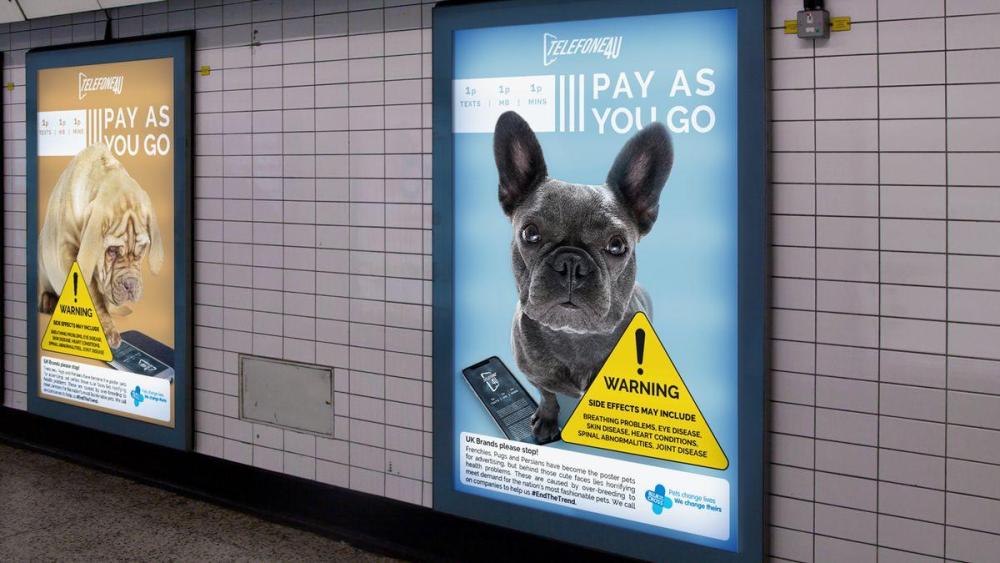The Great Divide - Responses to Challenges in Extreme Breeds
The Great Divide - Responses to Challenges in Extreme Breeds
Last week (Oct 2021) saw postings of two initiatives related to brachycephalic (flat-faced) and other extreme breeds. One was information on legal questions being put forward to demand that the UK Kennel Club not register ‘non-standard colours’ of certain breeds. The second was posters erected in, I believe, subway stations warning people of the problems of various breeds.
The first is essentially a complaint about colours typically accepted in the show world, and the desire to prevent dogs with less typical colours being considered pedigree dogs. However, many of these colours have been in the breed for decades if not centuries and the majority of them do not cause widespread, serious health issues. The posters warn people about significant conditions in breeds with extreme conformation (e.g. brachycephalic (flat-faced) dogs) that require expensive veterinary care for, e.g., breathing problems, spinal problems, and many other concerns. The legal argument is being put forward by groups of breed clubs and breeders; the second was posted by Blue Cross - a group of veterinary clinics and shelters in the UK. The Blue Cross initiative also ramps up the campaign to stop the use of compromised breeds in media and advertising which has been ongoing by various groups for years…without achieving total buy-in (see links below).
IPFD wrote in 2019 about the need to reframe conversations in the dog world (links below) to recognize the wide range of opinions, attitudes, and beliefs of different stakeholders and to encourage cooperation and collaboration. The two disparate efforts described this week reflect a continued divide between and across stakeholder groups. The situation also raises questions about the reasons behind the efforts. The actions taken by the veterinary group must be seen as a concern for individual dogs and breeds of dogs; presumably prompted by the extraordinary numbers of sick animals seen by these veterinarians and by the numbers of distraught owners struggling to pay for their care. These issues impact veterinarians through their concern for the animals and add to their ongoing stress which is at high levels due to the pandemic (see my blog and my recent V.I.N. article). The action by the breed clubs and breeders, on the other hand, is likely motivated more by human attitudes rather than animal issues. It will be perceived as individuals and groups being protective of their desire to maintain exclusivity/distinction in their hobby rather than as a primary concern for dog health and welfare. Even if they claim that some of these colours are associated with health problems, and a few are, the commonness and severity of these conditions cannot be compared to other more significant problems within these breeds. However, the coat colour issue can be more complicated where breeders are promoting rare or 'trendy colours of dogs and there are aspects being seriously addressed by The Kennel Club.
So, there you have it - the great divide - and it continues. The text published this year on Health and Welfare of Brachycephalic (Flat-faced) Companion Animals highlights many sides of the crisis facing these breeds - breeds that have become incredibly popular. At IPFD we continue to work to try to bring stakeholders together through our blogs and articles and our support of The International Collaboration on Extreme Conformation in Dogs (ICECDogs). Their work is an effort to bring national multi-stakeholder groups together internationally to find a way forward to address the complex issues of health and welfare in dogs who have been selectively bred with conformations which impinge on their health and welfare.
Coming together, the two actions described above and below highlight the disparity in approaches and the unfortunately narrow view of some within the dog show community. Once again, we call on all stakeholders in dog health and well being - including owners, breeders, judges, kennel and breed clubs, veterinarians, the pet industry - everyone - to try to find a way forward collectively, collaboratively and for the benefit of the health and welfare of dogs and good human dog interactions.
References and Links:
1. Reframing Current Challenges Around Pedigree Dogs: A Call for Respectful Dialogue, Collaboration, and Collective Actions https://dogwellnet.com/content/international-actions/think-globally-act-locally/reframing-current-challenges-around-pedigree-dogs-r707/
2. Bonnett blog: Veterinarians and Brachycephalic Dogs - Ethics and Reality https://dogwellnet.com/blogs/entry/205-veterinarians-and-brachycephalic-dogs-ethics-and-reality/
3. Bonnett on the Veterinary Information Network (V.I.N.) Banning brachycephalic breeds is unrealistic https://news.vin.com/default.aspx?pid=210&Id=10464873
 4. Blue Cross posters - posted by CRUFFA: "Well this one has taken us all by surprise - a new campaign from Blue Cross and very feisty it is"
4. Blue Cross posters - posted by CRUFFA: "Well this one has taken us all by surprise - a new campaign from Blue Cross and very feisty it is"
https://www.facebook.com/groups/cruffa/permalink/2904813753069095/
5.Blue CrossPetition: https://www.bluecross.org.uk/end-the-trend-brachycephalic-petition?fbclid=IwAR3hNVdF-0p19X1e7Y6pxeh3KU3IQMfgMZBCl0zmhJ6NHBIDwlWZQlD5xxY
 Donate
Donate

0 Comments
Recommended Comments
There are no comments to display.